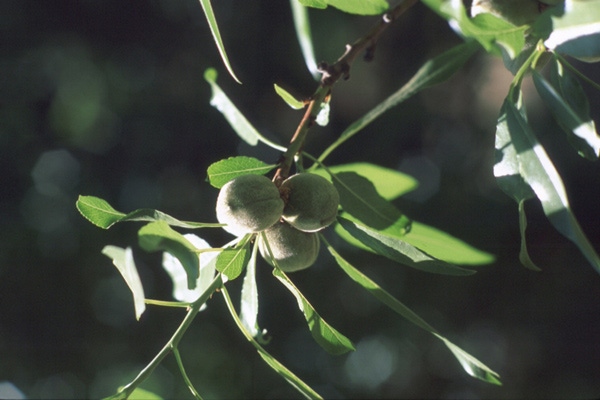July 20, 2016

Since potassium comes in many forms, it’s important to know how many pounds to apply to meet the kernel need of almonds.
This was among the points from David Doll, University of California Cooperative Extension (UCCE) farm advisor in Merced County in an internet posting where he also advised against the over application of the nutrient due to its cost.
Almonds remove about 72 pounds of elemental potassium for every 1,000 kernel pounds, Doll said. This is the equivalent 92 pounds of potassium oxide (K2O), the unit by which potassium fertilizers are measured. This means that for every 1,000 pounds of kernels removed, 92 pounds of K2O must be available to prevent future deficiency.
Doll said this is equivalent to 184 pounds of potassium sulfate (50 percent of K2O) or 368 pounds of potassium thiosulfate (25 percent of potassium oxide).
While applying too much potassium is unlikely to harm the tree, Doll said it can leach through the soil and be a waste of money.
To determine how much is needed, he recommends taking into account tissue levels plus a soil analysis.
If the soil analysis reveals potassium values are greater than 150 parts per million (ppm), the trees are less likely to respond to potassium applications. If high amounts of potassium are available in the soil at levels greater than 250 ppm, potassium rates could be reduced to help reduce costs.
If the levels are lower than 150 ppm, rates should be increased to help build reserves.
“Some soils, such as sands, cannot hold this much potassium,” Doll said.
A wealth of information on almond fertilization is available online at http://apps.cdfa.ca.gov/frep/docs/Walnut.html.
Research conducted by Roger Duncan, UCCE farm advisor for Stanislaus County, showed that orchards with potassium leaf levels greater than 2 percent did not have greater yields than orchards with leaf levels below 1.4 percent.
Duncan said potassium is important for producing root growth while producing large uniformly distributed xylem vessels in root systems.
“It increases the size and quality of fruits and nuts,” he said.
Deficiency symptoms include slow growth. Leaves can become pale, and leaf size and shoot growth are reduced. Leaf tips sometimes curl upward. He said that by the time you see deficiency symptoms, trees are already deficient and yield is lost.
Duncan said that while “the word on the street says K (potassium) values should be 2 percent or higher,” research has shown “increasing potassium levels above 1.4 percent may not lead to higher yields.”
He said data suggests that 1.4 percent levels of potassium in leaves sampled in July is “pretty close to the correct economic threshold.”
“I don’t argue with any grower who wants 2 to 3 percent K,” he added. “It’s their money.”
Duncan said it is important that any drip hoses should be over the applied band of potassium fertilizer, not distant from it. He adds that “banding,” applying the fertilizer in a line down the row of trees within the rooting zone, is not efficient in drip orchards.
“It’s better to inject,” he said.
Doll said potassium can be applied in granular form or though the irrigation system. Ground applications are often made during dormancy or in early spring. Depending on the soil type, he said the amount could vary from 50 percent to 100 percent of the potassium budget for the year.
Fertigated materials can be applied in season or during dormancy. Those products are thought to have a faster rate of tree uptake due to being suspended in soil water.
But Doll said those products are often more costly than ground applied fertilizers. Examples include potassium thiosulfate, potassium nitrate, potassium chloride, potassium carbonate, or high grade potassium sulfate.
For sandy soils, Doll said it’s best to apply a reduced later application during dormancy. The remainder should be applied from April to August.
With this program, he said 50 percent of the potassium budget could be applied as potassium sulfate in late January or February with the remainder applied in-season using potassium thiosulfate.
With heavier soils, Doll said it’s best to apply a larger percentage of the potassium budget during dormancy. Those soils might also require the application of gypsum or other calcium products to help saturate the soil and move potassium into the soil water.
Doll said potassium is pulled into the tree’s root zone at a constant rate throughout the season.
Other researchers have pointed to potassium fertilization as also being important for productivity of pistachio trees as well.
You May Also Like




